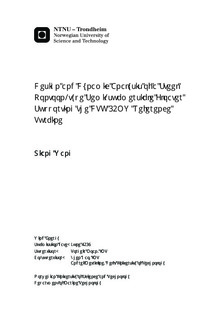Design and Dynamic Analysis of a Steel Pontoon-type Semi-submersible Floater Supporting the DTU 10MW Reference Turbine
Master thesis
Date
2014Metadata
Show full item recordCollections
- Institutt for marin teknikk [3397]
Abstract
In recent years, oshore wind energy has experienced a huge development. Floating windturbines may become competitive for water depth larger than 50m. However, high cost isstill the main challenge for the oshore wind industry. Floating oshore designs providesthe possibility to carry large wind turbines to reduce the cost per MWh.
In this thesis, a pontoon-type semi-submersible platform has been designed to supportthe DTU 10MW reference wind turbine. The initial design is made though upscaling ofan existing 5MW semi-submersible platform design. The design is then checked againstbuoyancy, stability, hydrodynamic and strength criteria. In addition a spread catenarymooring system has been designed based on the catenary theory. Further tests show thatclump weight might be needed to balance the strength and stiness of the mooring lines.
Floating wind turbine models with dierent levels of complexity have been establishedand studied through the thesis. In addition, viscous drag force and second order waveforce have been implemented. Finally the SIMO-RIFLEX-AeroDyn model is established,and extensive numerical tests have been performed to check the model. The modellingof blades, hub, nacelle and shaft has been found to be dicult and will result in somediculties in eigenfrequency prediction of the wind turbine. It is also found that theblade pitch controller can excite large platform pitch resonant motion at above ratedwind speeds, which could be possibly solved by reducing the PI gains of the controller.
Finally, time domain coupled dynamic analysis of the floating wind turbine system isperformed by the SIMO-RIFLEX-AeroDyn code. Characteristic responses of the semi-submersible floating wind turbine are studied and compared to those of the land-basedwind turbine. It is found that platform motions have limited influence on the aerodynamic performance of the wind turbine. Besides, operating at rated wind speed is found to produce the largest blade and tower bending moments for both land-based and floating wind turbines. For the floating wind turbine, resonant surge and pitch motions could be excited by turbulent wind under operational conditions which will dominate the response. Second order wave force has some influences on the surge and pitch resonant responses,but these influences are small comparing to those of turbulent wind. However, second order wave force could be important for the study of heave motion, which is wave force dominated even under turbulent wind conditions.
